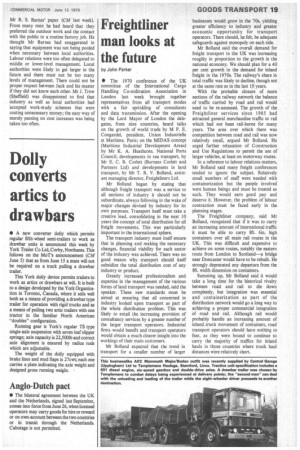Freightliner man looks at the future
Page 21

If you've noticed an error in this article please click here to report it so we can fix it.
by John Parker • The 1970 conference of the UK committee of the International Cargo Handling Co-ordination Association in London last week brought together representatives from all transport modes with a fair sprinkling of consultants and data transmission. After the opening by the Lord Mayor of London the delegates, from nine countries, heard talks on the growth of world trade by M P. E. Congardel, president, Union Industrielle et Maritime. Paris; on the MIDAS concept (Maritime Industrial Development Areas) by Mr K. A. Heathcote, National Ports Council; developments in sea transport, by Mr E. C. B. Corlett (Burness Corlett and Partners Ltd) and developments in land transport, by Mr T. R. V. Bolland, assistant managing director, Freightliners Ltd.
Mr Bolland began by stating that although freight transport was a service to all sections of industry it should not be subordinate, always following in the wake of major changes devised by industry for its own purposes. Transport itself must take a creative lead, consolidating in the next 10 years the concept of total distribution for all freight movements. This was particularly important in the international sphere.
The transport industry must itself ensure that in planning and making the necessary changes, financial viability for each sector of the industry was achieved. There was no good reason why transport should itself subsidize the total distribution cost of any industry or product.
Greatly increased professionalism and expertise in the management of the various forms of land transport was needed, said the speaker. These new standards must be aimed at ensuring that all concerned in industry looked upon transport as part of the whole distribution problem. This was likely to entail the increasing provision of consultancy services by a greater number of the larger transport operators. Industrial firms would benefit and transport operators would obtain a much clearer insight into the workings of their main customers.
Mr Bolland expected that the trend in transport for a smaller number of larger businesses would grow in the 70s, yielding greater efficiency to industry and greater economic opportunity for transport operators. There should, he felt, be adequate safeguards against monopoly on each side.
Mr Bolland said the overall demand for freight transport in the UK was increasing roughly in proportion to the growth in the national economy. We should plan for a 40 per cent growth in the demand for inland freight in the 1970s. The railway's share in total traffic was likely to decline, though not at the same rate as in the last lo years.
With the probable closure of more sections of the railway network the balance of traffic carried by road and rail would need to be re-assessed. The growth of the Freightliner services since 1965 had attracted general merchandise traffic to rail which had not been rail-borne for many years. The area over which there was competition between road and rail was now relatively small, argued Mr Bolland. He urged further relaxation of Construction and Use Regulations to permit the use of larger vehicles, at least on motorway routes.
In a reference to labour relations matters, Mr Bolland said many freight conferences tended to ignore the subject. Relatively small numbers of staff were needed with containerization but the people involved were human beings and must be treated as such. They would earn good pay and deserve it. However, the problem of labour contraction must be faced early in the planning stages.
The Freightliner company, said Mr Bolland, recognized that if it was to carry an increasing amount of international traffic it must be able to carry 8ft. 6in. high containers over all main rail routes in the UK. This was difficult and expensive to achieve on some routes, notably the eastern route from London to Scotland—a bridge near Doncaster would have to be rebuilt. He strongly deprecated any departure from the 8ft. width dimension on containers.
Summing up, Mr Bolland said it would take a long time for the historical rivalry between road and rail to die down completely, but integration was essential and containerization as part of the distribution network would go a long way to achieving a proper commercial integration of road and rail. Although rail would probably handle an increasing amount of inland_ounk movement of containers, road transport operators should have nothing to fear, as they were bound to continue to carry the majority of traffics for inland hauls in those countries where trunk haul distances were relatively short.
























































































































